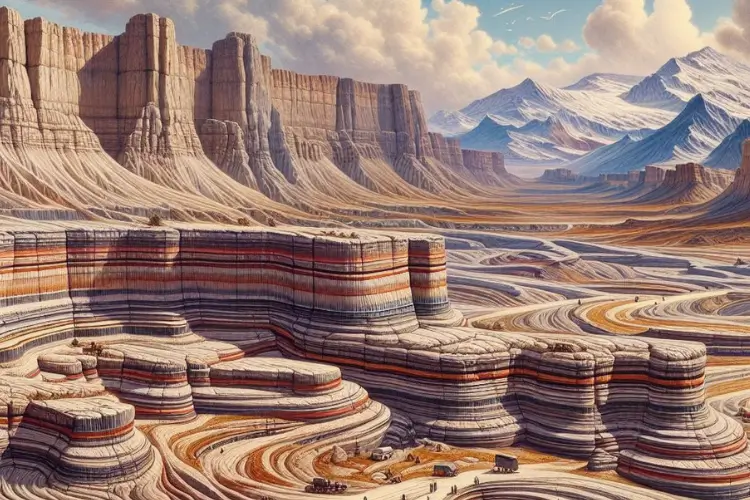Bedding or stratification is the single most characteristic feature of sedimentary rocks.
Sedimentary rocks are available in the form of strata. It is a layer of minerals.
A mineral layer will form on top of an existing mineral layer to make a large rock.
Sedimentary rocks can appear with different types of bedding.
Stratification, cross-bedding, and graded bedding are most abundant.
It is the shortest answer to the question of what is the single most characteristic feature of sedimentary rocks.
What Characteristic Is Used to Classify Detrital Sedimentary Rocks?
You can classify the detrital sedimentary rocks based on the grain size of the detrital particles.
If the grain size is more than two millimeters, it is known as gravel.
Sand has a grain size between the sixteenth part of a millimeter to two millimeters.
People call the detrital sedimentary rocks mud or clay when the grain size is less than sixteenth part of a millimeter.
It is easy to identify these rocks because each one presents a different physical form.
You can get sedimentary rocks in many forms and colors.
The grain size is the best way to classify them because other ways can complicate the classification.
Of the following list, which common mineral found in igneous rocks is the most abundant mineral in detrital sedimentary rocks?
You can choose Quartz from the list of minerals because it is the common mineral found in igneous rocks. It is also the most abundant mineral in the detrital sedimentary rocks.
Quartz is the second most abundant mineral on the earth’s surface.
Only Feldspar is more than quartz on the earth’s surface.
Quartz is part of most types of rocks. Igneous and sedimentary rocks have quartz crystals worldwide because of their abundance.
You can also find quartz in metamorphic rocks.
It is also part of the earth’s surface in every country.
You may find high-quality quartz with a specific color in some places.
There is no location for the clear quartz crystals.
Which of the following sedimentary features would typically be found in shales but not in sandstones?
You can find mud cracks in the shales but not in the sandstones.
Mud cracks form on the surface of the sedimentary rocks when the water dries from the surface.
If the rock surface loses water content, mud cracks can also appear.
The mud crack may start at a small place on the rock.
They will grow as the shales lose more water.
You will not find the mud cracks in the sandstones because the grains pack strongly in the stone.
There is no place for the grains to move and form cracks.
Sandstone has a larger grain size than mud grains.
The grains of the sandstone will not stick together as the mud grains do due to their smaller size.
What Are the Depositional Features Found in Sedimentary Rocks and How Do They Prevent Erosion?
Depositional features found in sedimentary rocks include cross-bedding, ripple marks, and mud cracks.
These features are formed by the accumulation and compaction of sediments over time. They prevent erosion by creating barriers and providing stability, effectively placing rocks to stop erosion.
What type of sandstone contains abundant feldspar?
Arkose is a sandstone that contains abundant feldspar.
Arkose is sandstone that consists of detrital sedimentary rocks.
It is different from most other types of rocks due to its Feldspar content.
Arkose can have more than 25 percent Feldspar.
You may see quartz in abundance in most rocks.
It is not the case with the Arkose.
You may also find calcite cement to hold the grains together in Arkose.
You will find most of the Arkose in gray color.
It can have a red color due to the iron oxide.
It is unsuitable to put it in acidic solutions as it may dissolve due to the calcite component.
These rocks form when the natural forces change the feldspar-rich rocks to change their form.
This stone becomes resistant after weathering as feldspar does not react to the acids and other chemicals.
For which of the following sediments does compaction play an important role?
Mud does compaction and plays an important role.
Mud compaction is better for storing the water and nutrients in the soil.
When the mud particles undergo a compaction process, the spaces between the grains will reduce.
The water molecules will stick to the grain surface due to the hydrogen bonding.
It is easy for the soil to retain the water molecules.
If there is no compaction in the solid, water will escape from the large spaces between the grains.
Water will also remove most nutrients when it moves from the soil. Soil compaction can increase soil strength.
It also prevents soil erosion because the mud particles pack together.
Knowing that the compaction process does not reduce the particle size is better.
It only reduces the spaces between these particles.
When the soil has more strength, it can support more plants.

